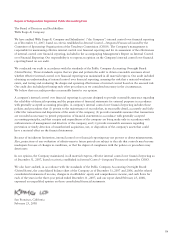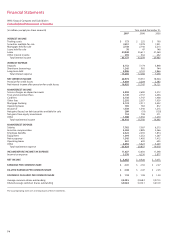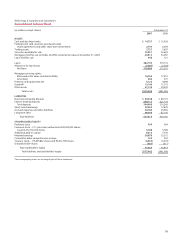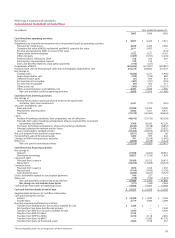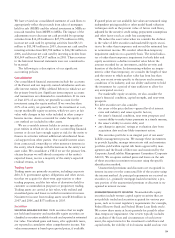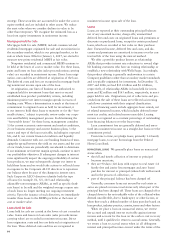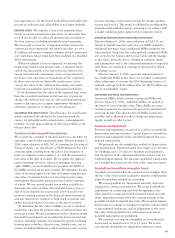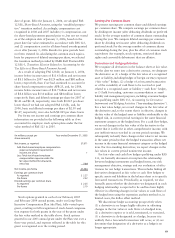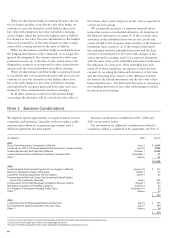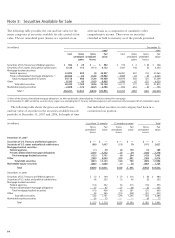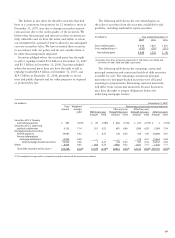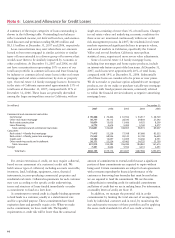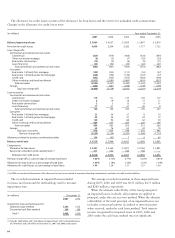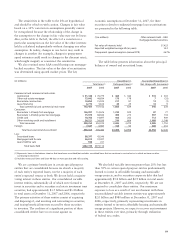Wells Fargo 2007 Annual Report Download - page 86
Download and view the complete annual report
Please find page 86 of the 2007 Wells Fargo annual report below. You can navigate through the pages in the report by either clicking on the pages listed below, or by using the keyword search tool below to find specific information within the annual report.
83
(in millions, except per Year ended December 31, 2005
share amounts)
Net income, as reported $7,671
Add: Stock-based employee compensation
expense included in reported net
income, net of tax 1
Less: Total stock-based employee
compensation expense under the
fair value method for all awards,
net of tax (188)
Net income, pro forma $7,484
Earnings per common share
As reported $ 2.27
Pro forma 2.22
Diluted earnings per common share
As reported $ 2.25
Pro forma 2.19
date of grant. Effective January 1, 2006, we adopted FAS
123(R), Share-Based Payment, using the “modified prospec-
tive” transition method. Accordingly, compensation cost
recognized in 2006 and 2007 includes (1) compensation cost
for share-based payments granted prior to, but not yet vested
as of the adoption date of January 1, 2006, based on the
grant date fair value estimated in accordance with FAS 123,
and (2) compensation cost for all share-based awards granted
on or after January 1, 2006. Results for prior periods have
not been restated. In calculating the common stock equiva-
lents for purposes of diluted earnings per share, we selected
the transition method provided by FASB Staff Position FAS
123(R)-3, Transition Election Related to Accounting for the
Tax Effects of Share-Based Payment Awards.
As a result of adopting FAS 123(R) on January 1, 2006,
income before income taxes of $11.6 billion and net income
of $8.1 billion for 2007 was $129 million and $80 million
lower, respectively, than if we had continued to account for
share-based compensation under APB 25, and, for 2006,
income before income taxes of $12.7 billion and net income
of $8.4 billion was $134 million and $84 million lower,
respectively. Basic and diluted earnings per share for 2007 of
$2.41 and $2.38, respectively, were both $0.025 per share
lower than if we had not adopted FAS 123(R), and, for
2006, basic and diluted earnings per share of $2.50 and
$2.47, respectively, were also both $0.025 per share lower.
Pro forma net income and earnings per common share
information are provided in the following table as if we
accounted for employee stock option plans under the fair
value method of FAS 123 in 2005.
Earnings Per Common Share
We present earnings per common share and diluted earnings
per common share. We compute earnings per common share
by dividing net income (after deducting dividends on preferred
stock) by the average number of common shares outstanding
during the year. We compute diluted earnings per common
share by dividing net income (after deducting dividends on
preferred stock) by the average number of common shares
outstanding during the year, plus the effect of common stock
equivalents (for example, stock options, restricted share
rights and convertible debentures) that are dilutive.
Derivatives and Hedging Activities
We recognize all derivatives in the balance sheet at fair value.
On the date we enter into a derivative contract, we designate
the derivative as (1) a hedge of the fair value of a recognized
asset or liability, including hedges of foreign currency exposure
(“fair value” hedge), (2) a hedge of a forecasted transaction
or of the variability of cash flows to be received or paid
related to a recognized asset or liability (“cash flow” hedge),
or (3) held for trading, customer accommodation or asset/
liability risk management purposes, including economic hedges
not qualifying under FAS 133, Accounting for Derivative
Instruments and Hedging Activities (“free-standing derivative”).
For a fair value hedge, we record changes in the fair value of
the derivative and, to the extent that it is effective, changes in
the fair value of the hedged asset or liability attributable to the
hedged risk, in current period earnings in the same financial
statement category as the hedged item. For a cash flow hedge,
we record changes in the fair value of the derivative to the
extent that it is effective in other comprehensive income, with
any ineffectiveness recorded in current period earnings. We
subsequently reclassify these changes in fair value to net income
in the same period(s) that the hedged transaction affects net
income in the same financial statement category as the hedged
item. For free-standing derivatives, we report changes in the
fair values in current period noninterest income.
For fair value and cash flow hedges qualifying under FAS
133, we formally document at inception the relationship
between hedging instruments and hedged items, our risk
management objective, strategy and our evaluation of effec-
tiveness for our hedge transactions. This includes linking all
derivatives designated as fair value or cash flow hedges to
specific assets and liabilities in the balance sheet or to specific
forecasted transactions. Periodically, as required, we also
formally assess whether the derivative we designated in each
hedging relationship is expected to be and has been highly
effective in offsetting changes in fair values or cash flows of
the hedged item using the regression analysis method or, in
limited cases, the dollar offset method.
We discontinue hedge accounting prospectively when
(1) a derivative is no longer highly effective in offsetting
changes in the fair value or cash flows of a hedged item,
(2) a derivative expires or is sold, terminated, or exercised,
(3) a derivative is de-designated as a hedge, because it is
unlikely that a forecasted transaction will occur, or (4) we
determine that designation of a derivative as a hedge is no
longer appropriate.
Stock options granted in each of our February 2005
and February 2004 annual grants, under our Long-Term
Incentive Compensation Plan (the Plan), fully vested upon
grant, resulting in full recognition of stock-based compensa-
tion expense for both grants in the year of the grant under
the fair value method in the table above. Stock options
granted in our 2003 annual grant under the Plan vest over a
three-year period, and expense reflected in the table for this
grant is recognized over the vesting period.


